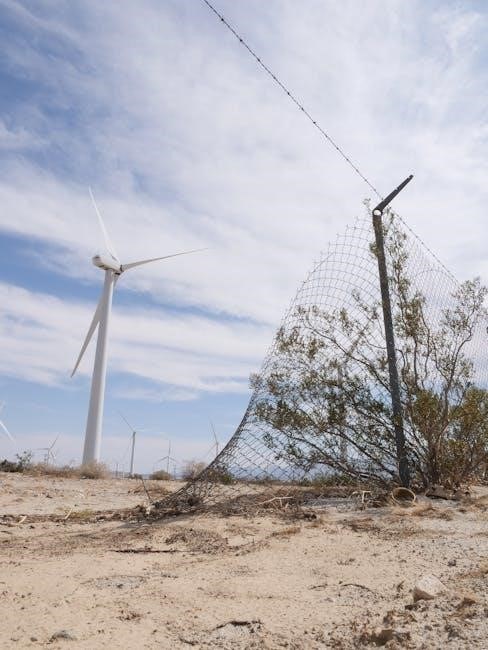Generac generator clearance requirements ensure safe and efficient operation‚ focusing on fire prevention‚ regulatory compliance‚ and maintenance access․ Proper clearances prevent hazards and meet NFPA 37 standards․
1․1 Importance of Proper Clearance for Generac Generators
Proper clearance for Generac generators is essential for safety‚ efficiency‚ and compliance with regulations․ It prevents fire hazards‚ ensures adequate airflow‚ and allows easy maintenance access․ NFPA 37 standards dictate minimum clearances to avoid fuel leaks and electrical risks․ Proper spacing also protects surrounding structures from heat damage․ Additionally‚ clearance ensures compliance with local building codes and manufacturer guidelines‚ avoiding potential legal issues․ Maintaining the required distances from walls‚ windows‚ and vegetation is critical to prevent obstructions and ensure reliable operation․ Proper clearance ultimately safeguards people‚ property‚ and the generator’s performance‚ making it a cornerstone of safe and efficient generator installation․

1․2 Overview of Key Clearance Requirements
Generac generator clearance requirements emphasize safety‚ compliance‚ and functionality․ Key clearances include 18 inches from walls‚ 5 feet from operable windows/doors‚ and 36 inches at the front/end for maintenance․ Vegetation‚ shrubs‚ and trees must be kept at least 36 inches away․ A minimum 5-foot clearance around the generator is recommended for service access․ These standards prevent fire hazards‚ ensure proper airflow‚ and comply with NFPA 37 guidelines․ Adhering to these requirements guarantees reliable operation‚ reduces risks‚ and meets local building codes․ Proper clearance is vital for maintaining efficiency‚ safety‚ and adherence to manufacturer and regulatory guidelines‚ ensuring optimal performance and longevity of the generator․

Key Considerations for Generator Installation
Key considerations include ensuring safety‚ compliance with local codes‚ and proper placement to maintain efficiency and avoid potential hazards and ensure reliable operation during power outages․
2․1 Safety and Fire Prevention
Safety and fire prevention are critical when installing Generac generators․ Proper clearance ensures the unit operates without overheating‚ reducing fire risks․ NFPA 37 standards require at least 18 inches of clearance from walls and 5 feet from operable windows or doors to prevent combustion hazards․ Vegetation‚ shrubs‚ and trees must be kept at a safe distance to avoid ignition sources․ Maintaining these clearances also allows for adequate airflow‚ which is essential for cooling and efficient performance․ Failure to adhere to these guidelines can lead to fire hazards‚ equipment damage‚ or carbon monoxide buildup‚ emphasizing the importance of strict compliance for safe operation․
2․2 Compliance with Local and National Codes
Compliance with local and national codes is essential for the safe and legal installation of Generac generators․ NFPA 37 provides national standards‚ requiring specific clearances to ensure fire safety and proper operation․ However‚ local regulations may vary‚ and it is crucial to verify requirements with local authorities․ These codes often include specifications for ventilation‚ electrical connections‚ and environmental factors․ Failure to comply can result in installation delays‚ legal penalties‚ or increased safety risks․ Always consult local building codes and work with certified professionals to ensure adherence to both national and regional guidelines‚ guaranteeing a safe and compliant generator installation․
2․3 Maintenance and Service Access
Maintenance and service access are critical considerations for Generac generator installations․ Proper clearance ensures technicians can easily perform repairs‚ routine maintenance‚ and inspections․ Generac recommends maintaining at least 5 feet of clearance around the generator to facilitate service access․ This includes ensuring front and end panels are accessible for maintenance tasks․ Additionally‚ generators should not be installed under wooden decks or structures unless there is at least 5 feet of clearance above the unit․ Proper access prevents delays in service and ensures the generator operates efficiently․ Always consult local authorities to verify specific requirements and ensure compliance with safety standards․

Clearance Requirements for Generac Generators
Generac generators require specific clearances from walls‚ windows‚ and vegetation to ensure safety and compliance with NFPA 37 standards‚ minimizing fire risks and ensuring proper operation․
3․1 Minimum Clearance from Walls and Buildings
Generac generators require a minimum of 18 inches of clearance from walls and stationary buildings to ensure proper ventilation and fire safety․ This clearance prevents heat buildup and potential ignition sources‚ aligning with NFPA 37 standards․ Additionally‚ maintaining this distance allows for easy access for maintenance and servicing․ Local codes may specify further requirements‚ so it’s essential to consult both manufacturer guidelines and regional regulations․ Proper spacing also ensures compliance with safety standards‚ reducing risks associated with improper installation․ Always verify specific clearance needs for your generator model to meet both safety and regulatory expectations․
3․2 Clearance from Windows‚ Doors‚ and Openings
Generac generators must maintain a minimum of 5 feet of clearance from operable windows‚ doors‚ and any openings in walls or structures․ This requirement ensures that exhaust fumes and heat are directed away from occupied spaces‚ reducing the risk of fire hazards and carbon monoxide exposure․ NFPA 37 standards emphasize this clearance to prevent potential ignition sources near flammable materials․ Additionally‚ local building codes may impose stricter regulations‚ so it’s crucial to verify specific requirements․ Proper spacing also ensures safe ventilation and compliance with safety standards‚ protecting both the generator and surrounding structures from potential damage or hazardous conditions․
3․3 Clearance from Vegetation (Shrubs‚ Trees‚ Bushes)
Generac generators require a minimum of 36 inches of clearance from shrubs‚ trees‚ and bushes to ensure safe operation and maintenance․ This distance prevents vegetation from obstructing airflow‚ which could lead to overheating or fire hazards․ Additionally‚ clearance from plants reduces the risk of debris interfering with the generator’s components․ NFPA 37 standards and manufacturer guidelines emphasize maintaining this space to avoid potential ignition sources near combustible materials․ Proper clearance also facilitates easy access for servicing and ensures compliance with fire safety regulations․ It’s important to regularly trim vegetation to maintain the required clearance and avoid any obstructions that could compromise the generator’s performance or safety․
3․4 Clearance from Overhead Structures
Generac generators must maintain a minimum of 5 feet of clearance from overhead structures‚ such as decks‚ awnings‚ or tree branches‚ to ensure safe operation and compliance with fire codes․ This clearance prevents potential fire hazards and allows adequate space for heat dissipation and ventilation․ Overhead obstructions can trap heat‚ leading to reduced efficiency or system failure․ Additionally‚ proper clearance ensures easy access for maintenance and repairs‚ as technicians need unobstructed space to service the unit․ Always consult local regulations and manufacturer guidelines for specific requirements‚ as they may vary based on installation location and environmental conditions․

NFPA 37 Requirements for Generator Clearance
NFPA 37 mandates minimum clearances for generators to ensure fire safety and proper maintenance access‚ including 18-inch wall clearance and 5-foot distance from windows or doors․
4․1 Minimum 18-Inch Clearance from Walls
NFPA 37 specifies that Generac generators must maintain a minimum 18-inch clearance from any stationary wall or building․ This requirement‚ based on testing by the Southwest Research Institute‚ ensures proper airflow and reduces fire hazards․ The clearance must be unobstructed‚ excluding vegetation like shrubs or trees‚ to maintain safe operation․ This standard applies to the back of the generator and is critical for compliance with fire safety regulations․ Adhering to this clearance ensures the generator operates efficiently while minimizing risks associated with heat buildup or ignition sources near combustible materials․

4․2 Minimum 5-Foot Clearance from Operable Windows and Doors
The NFPA 37 standard requires a minimum of 5 feet of clearance between Generac generators and any operable windows‚ doors‚ or openings in walls․ This regulation is crucial to prevent exhaust fumes‚ heat‚ or combustion byproducts from entering buildings‚ which could pose serious safety risks․ The 5-foot rule ensures that generators do not create hazardous conditions near openings that lead to inhabited spaces․ This clearance is non-negotiable and must be maintained regardless of other installation considerations․ Proper adherence to this requirement helps prevent fire hazards and ensures compliance with safety standards‚ protecting both people and property from potential dangers associated with generator operation․

4․3 Additional Clearance for Service and Maintenance
Generac generators require additional clearance to facilitate safe and efficient service and maintenance․ A minimum of 5 feet of clearance around the generator is recommended to provide easy access for technicians․ This space ensures that front and end panels can be removed without obstruction‚ allowing for proper inspection and repairs․ The clearance also prevents damage to the unit during maintenance activities․ Furthermore‚ this requirement ensures compliance with NFPA 37 standards‚ which prioritize safety and functionality․ Proper clearance not only aids in routine upkeep but also ensures that any potential issues can be addressed promptly‚ minimizing downtime and extending the generator’s lifespan․ Regular maintenance is essential for optimal performance․

Local and Regional Code Requirements
Local and regional codes often have specific requirements for generator installations‚ which may vary from national standards․ These codes ensure compliance with area-specific safety regulations․
5․1 Variations in Local Regulations
Local regulations for Generac generator installations can vary significantly‚ with some areas implementing stricter requirements than national codes․ These variations often address site-specific factors‚ such as climate‚ fire risks‚ or environmental concerns․ For instance‚ coastal regions may require additional clearances to account for high humidity or saltwater exposure․ Similarly‚ areas prone to wildfires might mandate greater distances from vegetation․ It’s crucial to consult local authorities to ensure compliance‚ as failure to meet regional codes can result in fines or installation delays․ Always verify specific requirements before proceeding with generator placement to avoid potential issues․ Local codes may also include unique stipulations not covered by national standards․
5․2 Importance of Consulting Local Authorities
Consulting local authorities is crucial to ensure compliance with specific regulations and safety standards for Generac generator installations․ Local codes may differ from national guidelines‚ and non-compliance can lead to legal issues or installation delays․ Authorities can provide detailed insights into site-specific requirements‚ such as environmental factors or community ordinances․ They ensure that clearances meet both national and local standards‚ preventing potential hazards․ Additionally‚ local experts can address unique challenges‚ like high-humidity areas or wildfire-prone regions‚ ensuring installations are both safe and compliant․ Always verify with local authorities to avoid fines or rework‚ as they offer tailored guidance for optimal generator placement and operation․

Environmental and Site-Specific Factors
Environmental factors like weather conditions and coastal humidity influence generator placement․ Site-specific challenges‚ such as flood zones or high winds‚ require adjusted clearances for safety and efficiency․
6․1 Impact of Weather Conditions on Clearance
Weather conditions significantly influence generator clearance requirements․ Coastal or high-humidity areas may require additional protective measures‚ such as weather-resistant materials‚ to prevent corrosion․ Generators in regions prone to heavy rain or snow must ensure proper drainage to avoid water accumulation near the unit․ In windy locations‚ secure anchoring is essential to maintain stability and prevent displacement․ Extreme temperatures can affect generator efficiency‚ necessitating adjustments in placement or insulation․ Ensure all clearances comply with NFPA 37 standards‚ even in challenging environmental conditions‚ to maintain safety and performance․
6․2 Considerations for Coastal or High-Humidity Areas
In coastal or high-humidity areas‚ Generac generators require special considerations to combat corrosion and moisture-related issues․ Saltwater exposure can accelerate rust‚ so weather-resistant materials and coatings are essential․ Regular inspections of electrical components are crucial to prevent damage from humidity․ Ensure proper sealing of enclosures and connections to maintain integrity․ Elevated installations may be necessary in flood-prone regions․ Additionally‚ drainage systems should be in place to manage water accumulation․ These measures ensure reliability and longevity‚ adhering to safety and performance standards in challenging environmental conditions․

Service and Maintenance Access Requirements
Generac generators require a minimum of 5 feet of clearance around all sides for easy service access․ Ensure front and end panels are accessible for maintenance․
7․1 Minimum 5-Foot Clearance Around the Generator
A minimum of 5 feet of clearance around all sides of the generator is essential for safe and efficient service access․ This ensures technicians can easily perform maintenance‚ repairs‚ or inspections without obstruction․ Proper clearance prevents potential safety hazards and facilitates compliance with regulatory standards․ Keeping the area free from vegetation‚ obstructions‚ and flammable materials is crucial․ This clearance also allows for adequate airflow‚ which is vital for the generator’s operation․ Always adhere to manufacturer guidelines and local codes to ensure compliance and maintain optimal performance․ Regular inspections of the clearance area are recommended to uphold safety and functionality standards․
7․2 Access for Front and End Panels
Ensuring unobstructed access to the front and end panels of a Generac generator is crucial for maintenance‚ repairs‚ and service․ These panels often house vital components that require regular inspection and servicing․ Adequate clearance ensures technicians can easily access these areas‚ promoting efficient and safe maintenance․ Generac recommends maintaining a clear path to these panels‚ free from vegetation‚ furniture‚ or other obstructions․ Proper access also aligns with safety standards‚ preventing potential hazards during servicing․ Always follow manufacturer guidelines to ensure compliance and optimal performance of the generator․ Regular checks of panel accessibility are essential to maintain reliability and operational efficiency over time․
Special Installation Scenarios
Special installations‚ such as under decks or in enclosed spaces‚ require specific clearance adjustments․ Ensure at least 5 feet of overhead clearance for under-deck setups and proper ventilation in enclosed areas to meet safety standards and manufacturer recommendations․
8․1 Installation Under Decks or Structures
Installing a Generac generator under decks or structures requires careful adherence to clearance guidelines․ Ensure at least 5 feet of overhead clearance above the generator to allow proper ventilation and maintenance access․ The unit must not be installed in enclosed or confined spaces without proper ventilation‚ as this can lead to carbon monoxide buildup․ Maintain minimum clearances of 18 inches from the back and 36 inches from the front and sides‚ keeping vegetation and obstructions within these boundaries․ Always consult local codes and manufacturer recommendations for specific installation scenarios to ensure safety and compliance with fire prevention standards․
8․2 Clearance for Generators in Enclosed Spaces
For Generac generators installed in enclosed spaces‚ maintaining proper clearance is critical to ensure safe operation and compliance with fire codes․ Ensure a minimum of 18 inches of clearance from walls and 5 feet from operable windows or doors to prevent carbon monoxide accumulation․ The enclosure must provide adequate ventilation to prevent heat buildup and ensure proper airflow for combustion․ Keep shrubs‚ trees‚ and other vegetation at least 36 inches away from the generator․ Always follow NFPA 37 guidelines and local regulations for enclosed installations; Proper clearance ensures efficient operation‚ reduces fire hazards‚ and facilitates maintenance access‚ while adhering to safety and environmental standards․
Proper clearance for Generac generators ensures safety‚ compliance‚ and efficient maintenance․ Adhering to NFPA 37 standards and local codes guarantees optimal performance and hazard prevention․
9․1 Summary of Clearance Requirements
Generac generators require specific clearances to ensure safety and compliance with regulations․ The minimum clearance from walls is 18 inches‚ while operable windows and doors need at least 5 feet․ Vegetation‚ such as shrubs and trees‚ must be kept 36 inches away from all sides․ Additionally‚ the top of the generator should maintain a minimum clearance of 48 inches‚ with 60 inches recommended․ These requirements‚ outlined in NFPA 37‚ are crucial for fire prevention and maintenance access․ Always consult local authorities to ensure compliance with regional codes and standards‚ as variations may apply․
9․2 Final Tips for Compliance and Safety
Ensure all Generac generator installations meet NFPA 37 standards and local codes․ Regularly inspect clearances to avoid fire hazards and maintain proper airflow․ Keep the area around the generator free of debris and flammable materials․ Always allow at least 5 feet of clearance from operable windows and doors․ Verify that vegetation is trimmed to meet the required 36-inch clearance․ Consult local authorities for site-specific regulations․ Schedule annual maintenance with certified technicians to ensure optimal performance․ By adhering to these guidelines‚ you can ensure safe‚ efficient‚ and compliant operation of your Generac generator‚ protecting both your property and the environment․
